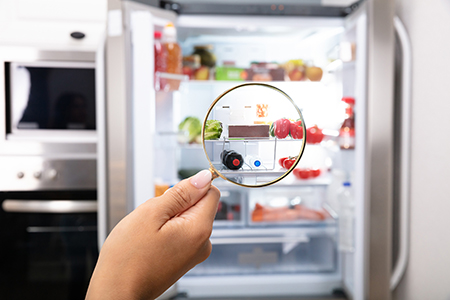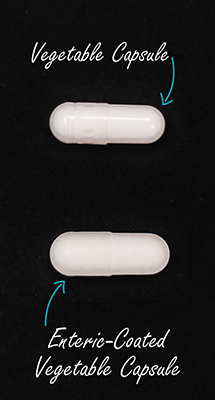What Do You Mean, “Probiotics Don’t Work?”
With over 30,000 published studies about them,[1] probiotics have been scientifically proven to help a multitude of conditions including antibiotic-associated diarrhea, eczema, colic, constipation, diarrhea, bacterial vaginosis, irritable bowel syndrome, high cholesterol levels, respiratory tract infections, traveller’s diarrhea, as well as Helicobacter pylori and Clostridium difficile infections.[2] Different strains have been studied for specific conditions, but overall, multistrain probiotics have been shown to be more effective.[3]
Yet, when I recommend probiotics to new patients, I am still surprised by how often they tell me:
“Probiotics do not work—I’ve tried, been taking them for years—did not see results.”
After some digging, we found out why… and, like most things, quality matters.
The Importance of Refrigeration
Let me ask you: Where do you keep your yogurt and your milk? They are sold in the fridge—and you keep them in the fridge. Not so difficult to reach in and get them out as you need them, is it? The recent rise in so-called “shelf-stable” probiotics, promising the convenience to store them in your cabinet, is one of the main reasons for problems related to efficacy—or lack, thereof. Probiotics are living cells and are therefore sensitive to heat and moisture. Alleged “room-stable” probiotics often report colony-forming unit counts at time of manufacturing, because counts will decline rapidly afterwards if the product is not refrigerated. Supposedly, room-temperature products often also mention refrigerating the product if room temperature exceeds 20 °C, which it almost certainly does in the summer.[4]
 “After 39 weeks of storage at 4 °C and 22 °C, the stability of the Lactobacillus rhamnosus and Lactobacillus casei/paracasei cultures was remarkably higher when stored under refrigeration (4 °C) compared to a storage at 22 °C.”[5]
“After 39 weeks of storage at 4 °C and 22 °C, the stability of the Lactobacillus rhamnosus and Lactobacillus casei/paracasei cultures was remarkably higher when stored under refrigeration (4 °C) compared to a storage at 22 °C.”[5]
Studies show that probiotics do not survive well at room temperatures.[6] Probiotic cells die off in the heat, and dead cells do not do any good. Refrigeration keeps the cells dormant, and it also improves the survival of all probiotic cells, especially the delicate and hard-working Bifidobacteria.
Delivery
Now let’s look at the actual capsule your probiotic comes in. Vegetable capsules are made of two halves and are designed to disintegrate. You may have seen “delayed-release” or “acid-resistant” capsules, but when tested, they are not holding up and are almost completely destroyed by stomach acid.[7] Studies show these unprotected capsules leak and disintegrate, leaving the probiotic cells they contain exposed to the acidity of the stomach.[8]
Stomach acid is very harsh; it is designed to break down food, but also to protect us from harmful invaders such as bacteria. This is what your probiotic capsule must soak in for 45–60 minutes, if not more. Research shows that certain strains of probiotics are completely destroyed within thirty minutes of becoming exposed to stomach acid.[9]
“This study [ . . . ] showed that among the probiotic capsules evaluated, only those that were enteric coated were able to resist to the degradation caused by stomach conditions. The results demonstrate the importance of protecting the bacteria by adding an enteric coating to the capsules.” [10]
 Studies show that a proven method to protect live probiotics from stomach acid is to use an enteric-coated capsule.[11] So, what is this incredible protection? Enteric coating is made using natural fats and a type of vegetable fibre. Enteric coating was developed to hold together in harsh acid and melt away once it hits your nonacidic small intestine: That’s where live probiotic cells do all their magic.
Studies show that a proven method to protect live probiotics from stomach acid is to use an enteric-coated capsule.[11] So, what is this incredible protection? Enteric coating is made using natural fats and a type of vegetable fibre. Enteric coating was developed to hold together in harsh acid and melt away once it hits your nonacidic small intestine: That’s where live probiotic cells do all their magic.
The research is clear: Probiotics protected with an enteric coating are more effective after exposure to stomach acid, and probiotics that are kept under refrigerated conditions (4 °C) are more viable than those kept at room temperature (25 °C).[12]
Reputable, professional supplement companies keep their probiotics cold and package them in capsules with an enteric coating. So, why settle for anything less?
Probiotics do work: They can work wonders for you—but only if you make the right choice.
 Dr. Ludovic Brunel, ND
Dr. Ludovic Brunel, ND
Dr. Brunel has 15+ years of experience as a Naturopathic Doctor and practices in Calgary. His approach has always been to improve health outcomes by relying on the best research available.
elevatedhealthcare.ca
[1] Pubmed search: Probiotics. https://pubmed.ncbi.nlm.nih.gov/?term=probiotics · Accessed May 2021.
[2] Gupta, V., and R. Garg. “Probiotics.” Indian Journal of Medical Microbiology, Vol. 27, No. 3 (2009): 202–209.
[3] Chapman, C.M., G.R. Gibson, and I. Rowland. “Health benefits of probiotics: Are mixtures more effective than single strains?” European Journal of Nutrition, Vol. 50, No.°1 (2011): 1–17.
[4] Jofré, A., T. Aymerich, and M. Garriga. “Impact of different cryoprotectants on the survival of freeze-dried Lactobacillus rhamnosus and Lactobacillus casei/paracasei during long-term storage.” Beneficial Microbes, Vol. 6, No. 3 (2015): 381–386.
[5] Jofré, Aymerich, and Garriga. “Impact of different cryoprotectants.”
[6] Bruno, F.A., and N.P. Shah. “Viability of two freeze‐dried strains of Bifidobacterium and of commercial preparations at various temperatures during prolonged storage.” Journal of Food Science, Vol. 68, No. 7 (2003): 2336–2339.
[7] Millette, M., A. Nguyen, K.M. Amine, and M. Lacroix. “Gastrointestinal survival of bacteria in commercial probiotic products.” International Journal of Probiotics and Prebiotics, Vol. 8, No. 4 (2013): 149–156.
[8] Corcoran, B.M., C. Stanton, G.F. Fitzgerald, and R.P. Ross. “Survival of probiotic lactobacilli in acidic environments is enhanced in the presence of metabolizable sugars.” Applied and Environmental Microbiology, Vol. 71, No. 6 (2005): 3060–3067.
[9] Corcoran et al. “Survival of probiotic lactobacilli in acidic environments.”
[10] Millette et al. “Gastrointestinal survival of bacteria in commercial probiotic products.”
[11] Govener, M., Y.E. Choonara, P. Kumar, L.C. du Toit, S. van Vuuren, and V. Pillay. “A review of the advancements in probiotic delivery: Conventional vs. non–conventional formulations for intestinal flora supplementation.” AAPS PharmSciTech, Vol. 15, No. 1 (2014): 29–43.
[12] Arepally, D, R.S. Reddy, and T.K. Goswami. “Studies on survivability, storage stability of encapsulated spray dried probiotic powder.” Current Research in Food Science, Vol. 3 (2020): 235–242.

 Stores
Stores